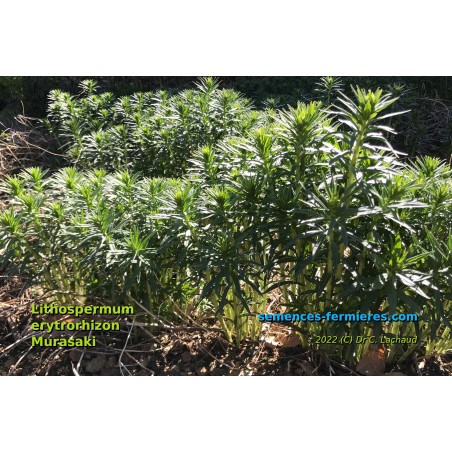



















- Murasaki - Purple Gromwell
1 packet of 30 seeds
-
Murasaki is a hardy perennial that sprouts from its stump each spring
Its stems are usually erect, but may lie down under the weight of the vegetation
They are branched and populated with small and fine leaves (3 to 5 cm long and 0.5 to 1 cm wide), running in a helix along the stems
Lithospermum erythrorhizon produces small, starry, white or yellowish-white, 5-petalled flowers
Flowers appear at the top of the stems successively as the plant grows, without interruption from April to June (plants older than 1 year) or from July to October (seedlings of the year)
The Flowers are melliferous and extremely attractive to bees, foraging in large numbers for weeks
Small gray seeds, hard as stone (Lithos: Stone, Spermum: Seed), grouped by 4, will follow soon
They may persist on dead stems part of the fall
The young roots of the Purple Gromwell are amazingly bright purple in spring
In summer, their color turns reddish-brown to bright red (depending on the soil pH and characteristics) - Erythro: Red, Rhizon: Root
On older plants, they form a reddish-brown woody stump
Traditionally in Japan, a purple or violet dye of very high value was made from Murasaki roots
The dye use of Zicao is delicate (several preparatory stages, including drying and extraction by long cold maceration in alcohol)
But the colors obtained are stunning
Lithospermum erythrorhizon is also a medicinal herb with the following properties: Anti-Inflammatory, Antitumor, Antiviral, Cardiotonic, Contraceptive, Depurative, Febrifuge, and Immunostimulant
It has long been used in cosmetic skin care
For medicinal use, the roots are harvested in autumn, the leaves in summer
The pigmentary and bioactive compounds of Lithospermum erythrorhizon are Shikonin and Alkannine, two Naphthoquinone molecules (red for the first, red-brown for the second - Alkannine being also present in the roots of Alkanna tinctoria, the famous Dyer's Alkanet)
These chemical substances are synthesized in the roots of Lithospermum erythrorhizon, and they play an important role in chemical warfare against other plants (negative allelopathy), as well as in controlling soil microbes in the rhizosphere
(for more data : https://www.nature.com/articles/s41438-020-0301-9)
Murasaki has become very rare in the countries of origin due to the intensive collection of wild specimens (threatened and protected species)
It is now grown by farmers in Japan (see https://youtu.be/7OiG-WjbCQA?t=804) and we recommend you do the same from our seeds
-
| Jan | Feb | Mar | Apr | May | Jun | Jul | Aug | Sep | Oct | Nov | Dec | ||
|---|---|---|---|---|---|---|---|---|---|---|---|---|---|
| Z5 | |||||||||||||
| etc. | |||||||||||||
Murasaki is very easy to grow
Sow in March, in pots, in the sun
Transplant outside at the end of May, in a well-draining soil, prepared and enriched with manure compost, in a sunny exposure
Make sure that the soil drains well, especially in the rainy season : Lithospermum erythrorhizon does not appreciate having its roots in poorly drained soil (will rot)
Murasaki can also be grown in large and deep pots
Water young plants copiously in times of drought or heatwave, as well as plants grown in pots
Established plants cultivated in soil will take care of themselves
First flowering may occur late in summer on the year of sowing, but is much earlier on the subsequent years
Dig up the roots of plants aged 1 or 2 years in spring, summer or fall
Clean and wash the roots of the Red Gromwell, then remove all dead parts (dead roots, etc.)
Finally, cut the roots into small sections in order to dry them
Once dry, you can grind them
You might also like
Payment :
PayPal < 150 €
Check < 850 €
Bank Wire > 149 €
Thank you for your kind understanding